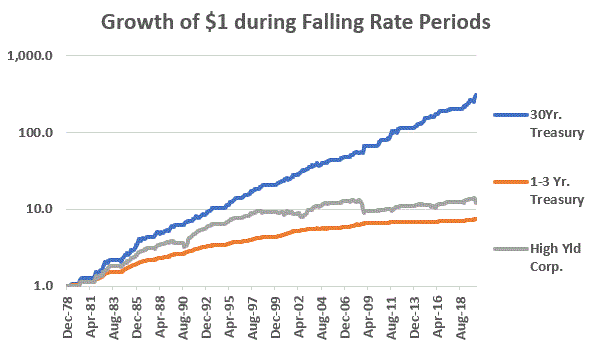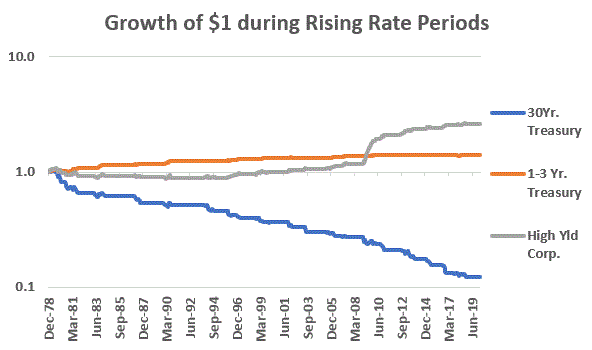In this article I highlighted the fact that the best predictor of the expected future return for bonds is their current yield. In this article I highlighted the fact that:
*Long-term bonds are great when rates are declining
*Long-term bonds are NOT great when rates are rising
*Bond yields have been in a massive downtrend for almost 4 decades
*Bond yields will not stay low forever
Investors who invest in bonds are in a very dangerous place at the moment. While there is seemingly very little risk of yields rising anytime soon, the reality is:
*Bonds aren’t generating much income at the moment
*Bond prices can appreciate more but only if yields decline more from current levels
*In the years ahead the bond market is unlikely to be the “sure thing” it has been for most of the past 30+ years
*Most investors are unaware of this and/or entirely unprepared to deal a rising interest rate environment
Bond Market Lesson – Part II
For our purposes we will look at bond total return data from 12/31/1978 through March 2020. During that time 30-year treasury yields rose from 8.8% to 15.2% by September of 1981. Since then the yield has worked its way lower to 1.35% at the end of March 2020.
We will look at the performance of:
*Bloomberg Barclays Long Treasury Index
*Bloomberg Barclay’s 1-3 Year Treasury Index
*Bloomberg Barclay’s High Yield Corporate Index (the first month of data I have for this index is July 1983. From January 1979 through June 1983 I used the monthly total return for ticker VWEHX – Vanguard High Yield Corporate fund)
Measuring Performance
We will look at performance in 3 different ways:
*Buy-and-hold
*ONLY during falling interest rate periods
*ONLY during rising interest rate periods
Since this is for illustrative purposes, we identified rising and falling interest rate periods with the benefit of perfect hindsight. Those periods appear in Figure 1.

Figure 1 – Rising and Falling Interest Rate Periods (1977-2020)
Figure 2 displays the buy-and-hold growth of $1 for all three indexes over 41 years and 2 months.

Figure 2 – Growth of $1 invested on a buy-and-hold basis (1978-2020)
Figure 3 displays growth of $1 ONLY during falling interest rate periods.

Figure 3 – Growth of $1 invested ONLY during rising rate periods (1978-2020)
Figure 4 displays growth of $1 ONLY during rising interest rate periods.

Figure 4 – Growth of $1 invested ONLY during falling rate periods (1978-2020)
Figure 5 displays cumulative returns for each type of bond during each of the periods detailed above.

Figure 5 – Bond returns (1978-2020)
The differences are stark and the conclusions are fairly simple:
*Falling interest rates are great for long-term bonds…
*…However, when rates rise, short-term treasuries and high-yield corporates are a much better play than long-term bonds
Summary
It is impossible to know when interest rates will finally bottom out and when a new “rising interest rate environment” will begin. But it is entirely possible to know what will happen when that day comes – long-term bonds will suffer significantly painful losses.
For a useful guide to how to know when that change is taking place, see Figure 7 in this article.
Stay tuned for Part III
Jay Kaeppel
Disclaimer: The information, opinions and ideas expressed herein are for informational and educational purposes only and are based on research conducted and presented solely by the author. The information presented represents the views of the author only and does not constitute a complete description of any investment service. In addition, nothing presented herein should be construed as investment advice, as an advertisement or offering of investment advisory services, or as an offer to sell or a solicitation to buy any security. The data presented herein were obtained from various third-party sources. While the data is believed to be reliable, no representation is made as to, and no responsibility, warranty or liability is accepted for the accuracy or completeness of such information. International investments are subject to additional risks such as currency fluctuations, political instability and the potential for illiquid markets. Past performance is no guarantee of future results. There is risk of loss in all trading. Back tested performance does not represent actual performance and should not be interpreted as an indication of such performance. Also, back tested performance results have certain inherent limitations and differs from actual performance because it is achieved with the benefit of hindsight.

